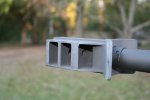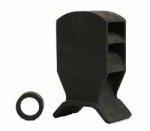I joined a machine tool night class around a month and a half ago and have gotten to know a couple of guys that have been in the day class for awhile. They are gun guys and as a side project during the night class they have been making muzzle breaks for AR type rifles. They have a few designs that look pretty cool. We got to talking the other night and they offered to make a .30 cal. one for my bolt gun. My question is what tolerance should there be for the round to pass through with out affecting accuracy or being dangerous? Also, for the brake to be effective and not just an ornament on the end of my rifle, what angles need to be cut in the ports? Is there a certain degree that is the sweet spot? Any thing else I should be weary of or need to measure for safety before I fire any rounds with it? I wanna make sure all is well before put it on a rifle I've spent a lot money and time on. Thanks for any input.
Vida
Vida



